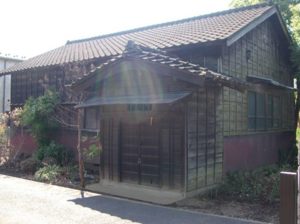The Hatsuunkan Dōjō
Before leaving for Kyōto in the 3rd year of Bunkyū (1863), Kondō Isamu adopted his older brother, Miyagawa Otogorō’s second son, Miyagawa Yūgorō (born in 1851). The boy was supposed to marry Tama, Kondō’s daughter (born in 2nd year of Bunkyū (1862), from a wedding with Matsui Tsune once the girl reached the age to be wed. Even though he did not probably receive any teaching from Kondō, Yūgorō was already practicing Tennen Rishin Ryū with his real father. Miyagwa Otogorō was a pupil of Tennen Rishin Ryū as well, since he joined the school together with his younger brother Katsugorō (the latter Kondō Isamu). After the death of Kondō in the 1st year of Meiji (1868), Yūgorō continued his training under several teachers. He probably studied with Harada Kamezō (son of Harada Chūji, a disciple of Kondō Shūsuke), despite another theory claiming that he was to become a pupil of Matsuzaki Watagorō (eldest son of Matsuzaki Shōsaku, student of the nidai Sansuke). Yūgorō eventually opened his own dōjō in the 9th of Meiji (1876) in Kami-ishihara (Chōfu city), calling it Hatsuunkan. It is said that Yamaoka Tesshū (1836-1888), the founder of Ittō Shōden Mutō Ryū and one of strongest swordsman of Bakumatsu and early Meiji periods, gave this name (translated literally as “the hall where the dark clouds are removed”) upon his arrival. In the 16th year of Meiji (1883), Yūgorō’s first son Hisatarō was born. However, his mother, Tama, died three years later (1886). The bloodline of Kondō Isamu ceased to exist when Hisatarō died in the Russo-Japanese war of 1905 at the age of twenty-two.
Yūgorō was remarried with a woman from Kokubunji city, called Tayo. From this union Kondō Shinkichi was born. Kondō Yūgorō eventually divorced from his new wife because she had a bad relationship with Matsui Tsune, the wife of Kondō Isamu and mother of Yūgorō’s wife Tama. The third and the last marriage the godaime contracted was with a girl name Kashi.
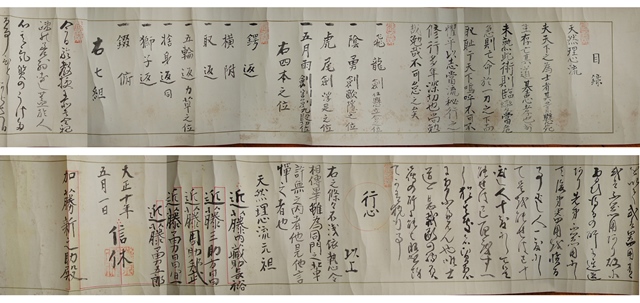
A Mokuroku issued by Kondō Yūgorō during the 10th of Taishō (1921)
Kondō Yūgorō died in the 8th year of Shōwa (1933), aged 83. Under his direction, the Hatsuunkan greatly flourished, gathering thousands of practitioners in the Tama area. At the beginning of Shōwa period he was interviewed by Shimozawa Kan (1892-1968), a writer whose Shinsengumi related books would go to inspire an entire literature genre in regards to the swordsmen corps. In fact, a large portion of Tennen Rishin Ryū’s fame was due to jidai shōsetsu (historical novels).
The best disciple of Kondō Yūgorō, Sakurai Kinpachi, inherited the title of 6th generation headmaster when his teacher was still alive. However, in the 7th year of Shōwa (1932), he was forced to leave the school since he moved to Hokkaidō. The school’s fate was then passed to Yūgorō’s son, Shinkichi, who became the 7th generation headmaster (nanadaime). Shinkichi also served as a Kendō assistant teacher (joshu) for the Keishichō, the police department.

A Kirigami issued by Kondō Shinkichi during the 3rd of Shōwa (1928)
Unfortunately, Kondō Shinkichi died in his early forties during the 11th year of Shōwa (1936). Afterwards, the Kondō line was left without guidance for several years until a new pupil, named Katō Isuke (student of Yūgorō and Shinkichi), returned from the war to claim the position of headmaster.
Katō Isuke was born in 44th year of Meiji (1911) and began learning Tennen Rishin Ryū under Kondō Yūgorō at the age of ten. From then on, he continued practicing with Shinkichi until he was sent to China during the Second Sino-Japanese War.
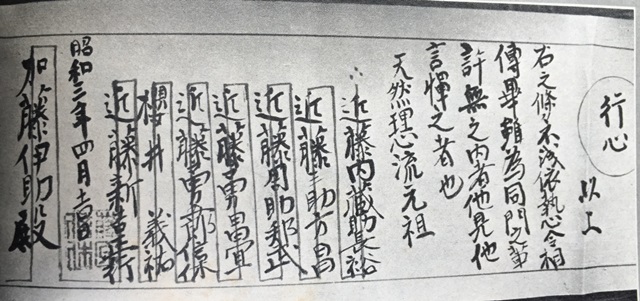
Copy of Katō Isuke’s Mokuroku, issued by Kondō Shinkichi in the 3rd of Shōwa (1928)
The Hatsuukan opened again in the 23rd year of Shōwa (1948), three years after the end of the Pacific War. After many years, practitioners would gather with a will to restore the name of the school. This group eventually created the Mitaka Kendō Federation also. In the 33rd year of Shōwa the Kondō Isamu Shiseki Honzonkai (Association for the preservation of the historical sites related to Kondō Isamu) was created. This association would eventually change its name to Tennen Rishin Ryū Monjinkai (Association of Tennen Rishin Ryū practitioners). During the 36th year of Shōwa (1961) two brothers, Hirai Taisuke (born in 1946) and Hirai Masato (born in 1949), joined the school. Within only three years, they became assistant Kendō teachers for the Mitaka Police Department. In 1975, with the Hirai brothers, Katō Isuke began to teach Tennen Rishin Ryū at the Mitaka Budōkan, since the Hatsuunkan was scarcely used anymore (it was rebuilt in 1931).

The Mitaka Budōkan, located in Shimorenjaku, Mitaka city
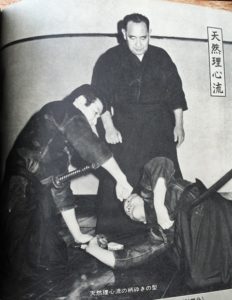
Katō Isuke, during a training session at the Mitaka Budōkan, watches carefully the Hirai brothers performing a jūjutsu technique
In the 54° year of Shōwa (1979) the Nihon Kobudō Kyōkai (Japanese Ancient Martial Arts Association) was established. Tennen Rishin Ryū was immediately asked to join with Katō Isuke being recognized as the 8th generation headmaster (hachidaime). From that year onwards the school participated in many martial arts exhibitions (enbu taikai), in both Japan and abroad (including France and Australia).

Hirai Taisuke and Hirai Masato demonstrating Tennen Rishin Ryū during the several enbu taikai held by the Nihon Kobudō Kyōkai
During the 7th enbu taikai (1985) Katō Isuke received the Kobudō Kōrōsha Hyōshō, the highest, most traditional martial arts decoration award of the Nihon Kobudō Kyōkai due to his efforts directed towards preserving Tennen Rishin Ryū. He would pass away at the age of eighty during the 3th year of Heisei (1991). Throughout his life, he practiced and taught Tennen Rishin Ryū, and would become a Kendō hanshi, as well.
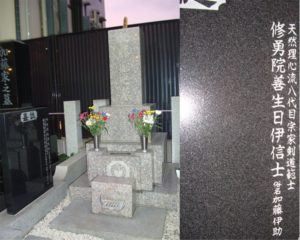
Katō Isuke’s grave in Iguchi, Mitaka city. To the right of his name one can read “Tennen Rishin Ryū hachidaime Sōke Kendō Hanshi”
After his teacher’s death, Hirai Taisuke inherited the leadership of the school, becoming the 9th generation headmaster (kyūdaime). In the 9th year of Heisei (1997), he moved the honbu dōjō of the school to the Iguchi Community Center of Mitaka city, near the graveyard where Katō Sensei rests.
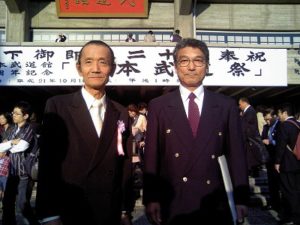
Hirai Taisuke with his brother Masato during a Nihon Kobudō Kyōkai reception

Hirai Taisuke during an enbu held at Ise Shrine, performing Muitsuken, a Chūgokui Mokuroku technique
Hirai Taisuke led the school for twenty-two years, passing away in October of 2013. He was the first Tennen Rishin Ryū teacher who taught foreign practitioners, allowing some of them the permission to open a shibu outside Japan.
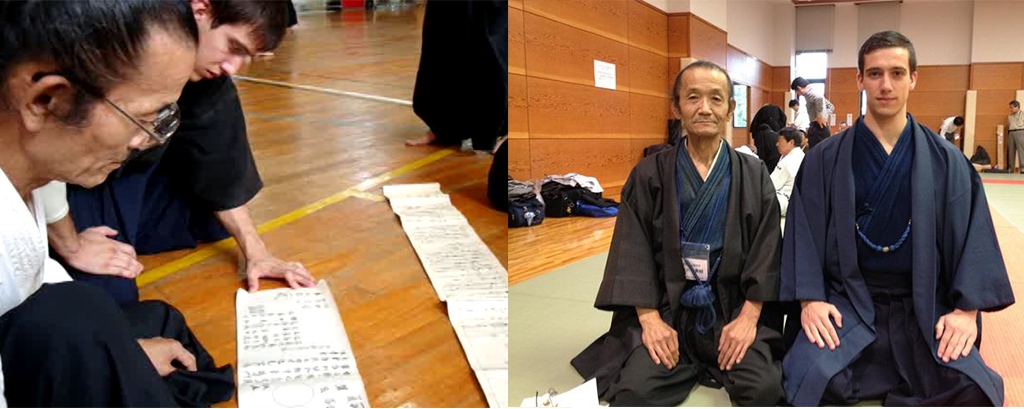
Hirai Taisuke with his disciple Sandro Furzi, appointed as the Italian branch dōjō instructor of Tennen Rishin Ryū in 2009
Today his younger brother, Hirai Masato, represents the school as the 10th generation headmaster (jūdaime) among the Nihon Kobudō Kyōkai.
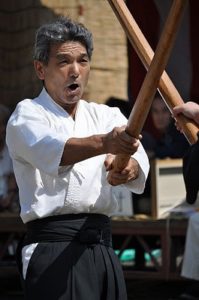 back to Origins continue to Bujutsu Hozonkai
back to Origins continue to Bujutsu Hozonkai
References
- Hachiōjishi Kyōiku Iinkai, Hachiōji no Tennen Rishin Ryū – Uketsugareta kenjutsu, jūjutsu, bōjutsu, Hachiōjishi Kyōdo Shiryōkan, 2008
- Kojima Masataka, Bujutsu Tennen Rishin Ryū – Shinsengumi no genryū wo tazunete, Kojima Shiryōkan, 1978
- Watatani Kiyoshi, Yamada Tadashi, Bugei Ryūha Daijiten (Zōho Daikaitei), Tōkyō Kopii Shuppanbu, 1978

